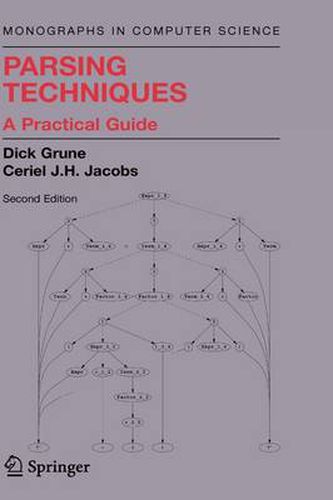Readings Newsletter
Become a Readings Member to make your shopping experience even easier.
Sign in or sign up for free!
You’re not far away from qualifying for FREE standard shipping within Australia
You’ve qualified for FREE standard shipping within Australia
The cart is loading…






This title is printed to order. This book may have been self-published. If so, we cannot guarantee the quality of the content. In the main most books will have gone through the editing process however some may not. We therefore suggest that you be aware of this before ordering this book. If in doubt check either the author or publisher’s details as we are unable to accept any returns unless they are faulty. Please contact us if you have any questions.
Parsing–syntax analysis by computer–has been and continues to be an essential part of computer science. Parsing techniques have provided a solid basis for compiler construction since the mid-1960s, and continue to do so, thereby contributing to all existing software today. They enable Web browsers to analyze HTML pages, and PostScript printers to analyze PostScript, among other things; and some of the more advanced techniques are being used in code generation in compilers and in data compression. In linguistics, the importance of formal grammars was recognized early on, but only relatively recently have the corresponding parsing techniques been applied extensively; and their importance as general pattern recognizers is slowly being acknowledged. Today, with problems of speed and memory largely out of the way, these general techniques have grown considerably in importance, both in computer science, where advanced compilers now often use general CF parsers, and in computational linguistics, where such parsers are the only option. They are used in a variety of software products including web browsers, interpreters in computer devices, and data compression programs; and they are used extensively in linguistics. To provide readers with low-threshold access to the full field of parsing techniques, this second edition uses a two-tiered structure. The basic ideas behind the dozen or so existing parsing techniques are explained in an intuitive and narrative style, starting from first principles of data structures and algorithms; this provides breadth and accessibility. The hundreds of realizations and improvements of these techniques are then explained in a much terser, yet still informal, style in the summaries of more than 700 papers referenced in the book; this provides depth.
$9.00 standard shipping within Australia
FREE standard shipping within Australia for orders over $100.00
Express & International shipping calculated at checkout
This title is printed to order. This book may have been self-published. If so, we cannot guarantee the quality of the content. In the main most books will have gone through the editing process however some may not. We therefore suggest that you be aware of this before ordering this book. If in doubt check either the author or publisher’s details as we are unable to accept any returns unless they are faulty. Please contact us if you have any questions.
Parsing–syntax analysis by computer–has been and continues to be an essential part of computer science. Parsing techniques have provided a solid basis for compiler construction since the mid-1960s, and continue to do so, thereby contributing to all existing software today. They enable Web browsers to analyze HTML pages, and PostScript printers to analyze PostScript, among other things; and some of the more advanced techniques are being used in code generation in compilers and in data compression. In linguistics, the importance of formal grammars was recognized early on, but only relatively recently have the corresponding parsing techniques been applied extensively; and their importance as general pattern recognizers is slowly being acknowledged. Today, with problems of speed and memory largely out of the way, these general techniques have grown considerably in importance, both in computer science, where advanced compilers now often use general CF parsers, and in computational linguistics, where such parsers are the only option. They are used in a variety of software products including web browsers, interpreters in computer devices, and data compression programs; and they are used extensively in linguistics. To provide readers with low-threshold access to the full field of parsing techniques, this second edition uses a two-tiered structure. The basic ideas behind the dozen or so existing parsing techniques are explained in an intuitive and narrative style, starting from first principles of data structures and algorithms; this provides breadth and accessibility. The hundreds of realizations and improvements of these techniques are then explained in a much terser, yet still informal, style in the summaries of more than 700 papers referenced in the book; this provides depth.